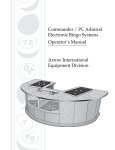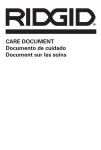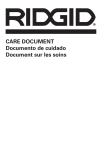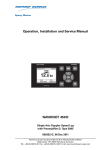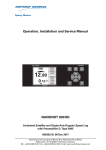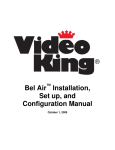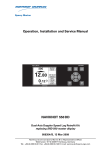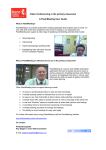Download Symbio Microscope L1500 Series Biological Upright Compound
Transcript
Symbio Microscope L1500 Series Biological Upright Compound Microscopes Operating Manual 1 Symbio, Unit 8, Coopers Place, Combe Lane, Wormley, Surrey. GU8 5SZ Tel: 44 (0) 1428 685762 Fax 44 (0) 1428 685702 www.symbio.co.uk [email protected] The GXM L1500 Series of biological microscopes are high quality instruments equipped with high grade, glass objectives in steel barrels which can be achromatic (model GXML1500A) or economic plan achromatic (model GXML1500B) and wide field eyepieces. They can be supplied with monocular, binocular or trinocular heads providing the observer with a bright, clear image and a wide field of view. These highly robust microscopes are suitable for scientific research, routine work in hospitals and government agencies and are especially popular as teaching tools in universities and colleges. SPECIFICATIONS . 1 Eyepieces Type Magnification Focus(mm) Field(mm) Wide field eyepiece 10X 25 φ18 Plan eyepiece 16X 15.6 φ11 Remark Optional . 2 Objectives Type W.D(mm) Achromatic or Semi- Plan Achromatic Magnification N.A 4X 10X 40X ( ) 100X oil Achromatic Semi-Plan 0.1 0.25 0.65 37.4 6.6 0.64 23.1 4.1 0.6 1.25 0.19 0.38 . 3 Total Magnification Objectives Total Magnification 4X 10X 40X 100X 10X 40X 100X 400X 1000X 16X 64X 160X 640X 1600X Eyepieces 4. Condenser numerical aperture: 1.25 ; ; 5. Stage cross travel range: longitudinal 35mm traverse 75mm 6. Fine focusing knob: minimum division 0.002mm ; ; 7. Interpupillary-distance adjustment range: from 53mm to 75mm 8. Light sources: using a 6V 20W-halogen or LED lamp brightness adjustment 9. Power supply: can be operated on AC 220V 50HZ or AC 110V 60HZ. ; 2 Symbio, Unit 8, Coopers Place, Combe Lane, Wormley, Surrey. GU8 5SZ Tel: 44 (0) 1428 685762 Fax 44 (0) 1428 685702 www.symbio.co.uk [email protected] COMPONENTS 3 Symbio, Unit 8, Coopers Place, Combe Lane, Wormley, Surrey. GU8 5SZ Tel: 44 (0) 1428 685762 Fax 44 (0) 1428 685702 www.symbio.co.uk [email protected] Fig.1 Fig.2 4 Symbio, Unit 8, Coopers Place, Combe Lane, Wormley, Surrey. GU8 5SZ Tel: 44 (0) 1428 685762 Fax 44 (0) 1428 685702 www.symbio.co.uk [email protected] INSTALLATION Fig.3 MAKING OBSERVATIONS 1. Press the power switch on the side “I”. Place a specimen on the stage 2. Select the 10X objective into position by turning the nosepiece, then focus the specimen which is on the stage ; ; 3. Adjust interpupillary distance and diopter whilst observing through the binocular eyepieces 4. Adjust the up & down position of the condenser, light control and aperture diaphragm in order to obtain the optimal illumination effect. Select the 4X or 10X objective, bring down the condenser using the condenser’s rack and pinion knob to obtain symmetrical light ; 5. When selecting other objectives turn the nosepiece and refocus slightly with the fine focusing knob. When use the 100X objective, make be sure to put a drop of cedar wood oil between the objective and the specimen. 5 Symbio, Unit 8, Coopers Place, Combe Lane, Wormley, Surrey. GU8 5SZ Tel: 44 (0) 1428 685762 Fax 44 (0) 1428 685702 www.symbio.co.uk [email protected] COMPONENT FUNCTIONS 1. Adjust of interpupillary distance Put the specimen on the stage and ring the specimen into exact focus. Adjust the interpupillary distance of binocular until the right-left field of view can be composed one. (Fig.4) Fig.4 2. Adjustment of diopter Put the specimen on the stage. Turn the 40X objective to working position. Firstly, observe at right column with right eye, adjust coarse-fine focusing knob to image clearly. Secondly, observe at left column with left eye, adjust the diopter control clearly. ( Fig.5) ① to image Fig.5 3. Coarse/Fine focusing The instrument used coaxial coarse/fine focusing mechanism. The adjustable tensional knob ④ used for adjusting the ③ to prevent the stage from naturally sliding down. The limit knob ① prevents accidental specimen/objective contact. ② is fine focusing tension of the coarse focusing knob knob.( Fig.6) Fig.6 6 Symbio, Unit 8, Coopers Place, Combe Lane, Wormley, Surrey. GU8 5SZ Tel: 44 (0) 1428 685762 Fax 44 (0) 1428 685702 www.symbio.co.uk [email protected] 4. Stage ① on stage is used for holding slide glass ②, lengthwise knob③/cross knob ④ are coaxial, the The convenient specimen holder stage move expediently.( Fig.7) Fig.7 5. Moving the condenser The condenser is moved up or down via turning up-down knob ①. The condenser can be taken down easily if unscrews the condenser holding screw②, filter plate places on the filter seat ④. (Fig.8) Fig.8 6. Power switch and adjustable brightness Turn on the power switch ⑥; adjust the light control ⑤ until image can be observed comfortably. (Fig.8) Note: Do not let the light control stay at the highest intensity position or it will reduce the life-span of the lamp. 7. Aperture diaphragm Switch on the power, put the specimen on the stage, then turn the 10X objective into the working position, observe with 10X eyepieces. Turning the up/sown condenser knob and reach the image of field diaphragm. Then concenter field diaphragm and optical axis with adjusting screw Fig.9 the ring ②. Turn ① of field diaphragm when the field diaphragm more than the field of eyepiece. Using 4X objective, the adjust method as so. (Fig.9) 7 Symbio, Unit 8, Coopers Place, Combe Lane, Wormley, Surrey. GU8 5SZ Tel: 44 (0) 1428 685762 Fax 44 (0) 1428 685702 www.symbio.co.uk [email protected] (Fig.10) 8. CHANGING THE LAMP (NOT NECESSARY FOR LED MODELS) AND FUSE 1. Switch off the power supply and pull out the plug of electrical wire. 2. Incline the microscope, loose the screw base boards ② of fixing lamp ③ on the middle part of bottom, and removes lamp baseboard from bottom. ④ 3. Pull out the old lamp from lamp base . Fig.10 4. Insert the new lamp into lamp base. Check it is properly connected. 5. Clean the new lamp with methanol. 6. Reinstall lamp base board on the bottom with the screw. 7. To check the positioning of the lamp, plug in the cable, turn on the power supply, select a low power objective, adjust condenser, and make the light enter the field of view. If the light is offset from the center of the field of view, loosen the screw and slightly and move the lamp base to make the lamp centered, then tighten the screw. 8. Unplug from the mains. Loosen the screw of fuse, remove the bad fuse, mount the new fuse, and tighten the screw. The specification of fuse :φ5,0.5A MAINTENANCE 1. Cleaning the optics Clean the optics using lens tissue or soft fabric immersed in methanol. Clean off excess immersion oil from the 100X objective after every use. . 2 Cleaning the painted parts The dust on the painted parts can be removed by a lint free cloth or blower brush, for the grease spots, the gauze immersed slightly with methanol is recommended. 3. Avoid disassembling the microscope Being a precise instrument, do not disassemble the microscope casually that may cause serious damage to its performance. 4. Being not used Cover the microscope with a dust cover and store in dry place. We recommend that storage all objectives and eyepieces should be in closed container with drying agent. 8 Symbio, Unit 8, Coopers Place, Combe Lane, Wormley, Surrey. GU8 5SZ Tel: 44 (0) 1428 685762 Fax 44 (0) 1428 685702 www.symbio.co.uk [email protected] SYMBIO MICROSCOPES SLIDER PHASE CONTRAST KITS USER MANUAL Example Phase Objectives Slider-Type Phase contrast condensers with inserts 9 Symbio, Unit 8, Coopers Place, Combe Lane, Wormley, Surrey. GU8 5SZ Tel: 44 (0) 1428 685762 Fax 44 (0) 1428 685702 www.symbio.co.uk [email protected] Introduction The Symbio microscope is supplied with a flashboard phase contrast set containing x10 and x40 phase flashboards. When viewing with phase contrast, the flashboard corresponding to the lens magnification should be inserted into the slot in the condenser (see flashboard phase contrast set picture above). The microscope condenser has been set up and aligned at the factory and should not need any significant user adjustments. The Centering Telescope can be used to check the alignment of the flashboards in the condenser (see diag. 1.). If the flashboards are out of alignment, they can be centered using the condenser adjustment screws (see Fig. 1. In the Operating Manual) When you wish to make observations using phase contrast phase contrast you need to select a phase contrast objective and ensure that the phase contrast condenser is mounted with the corresponding phase contrast plate inserted which must have the same magnification indicated on it as the objective currently selected. See below example: Operating Procedure 1. Select a phase contrast objective, insert the corresponding phase contrast plate in position, adjust the condenser knob to move the condenser into the optimum position. 2. Place a specimen slide on the stage, and focus onto the specimen. 3. Remove one eyepiece and insert the centering telescope 2 , as in diag 1-a 4. Look through the phase telescope and observe the dark ring 3 and bright ring 4, as in diag 1c 5. If the ring edges are not clear enough, adjust the phase telescope extension ring 1 to bring it into focus. 6. Phase contrast observation requires that the center of dark and bright rings are perfectly concentric. If they are not concentric (non-concentricity is shown in diag 1-c), adjust the centering screws of the phase plate 5 as shown in diag 1b, the correct observed setting should be as shown in diag 1-d 7. When you have completed the phase ring alignment remove the centering telescope and insert the eyepiece. Please Note: When you change to a different power objective, the phase system will require re-adjustment to ensure optimum phase contrast performance. 10 Symbio, Unit 8, Coopers Place, Combe Lane, Wormley, Surrey. GU8 5SZ Tel: 44 (0) 1428 685762 Fax 44 (0) 1428 685702 www.symbio.co.uk [email protected] 3 1 4 2 c a b 5 d Diag 1. 11 Symbio, Unit 8, Coopers Place, Combe Lane, Wormley, Surrey. GU8 5SZ Tel: 44 (0) 1428 685762 Fax 44 (0) 1428 685702 www.symbio.co.uk [email protected]











